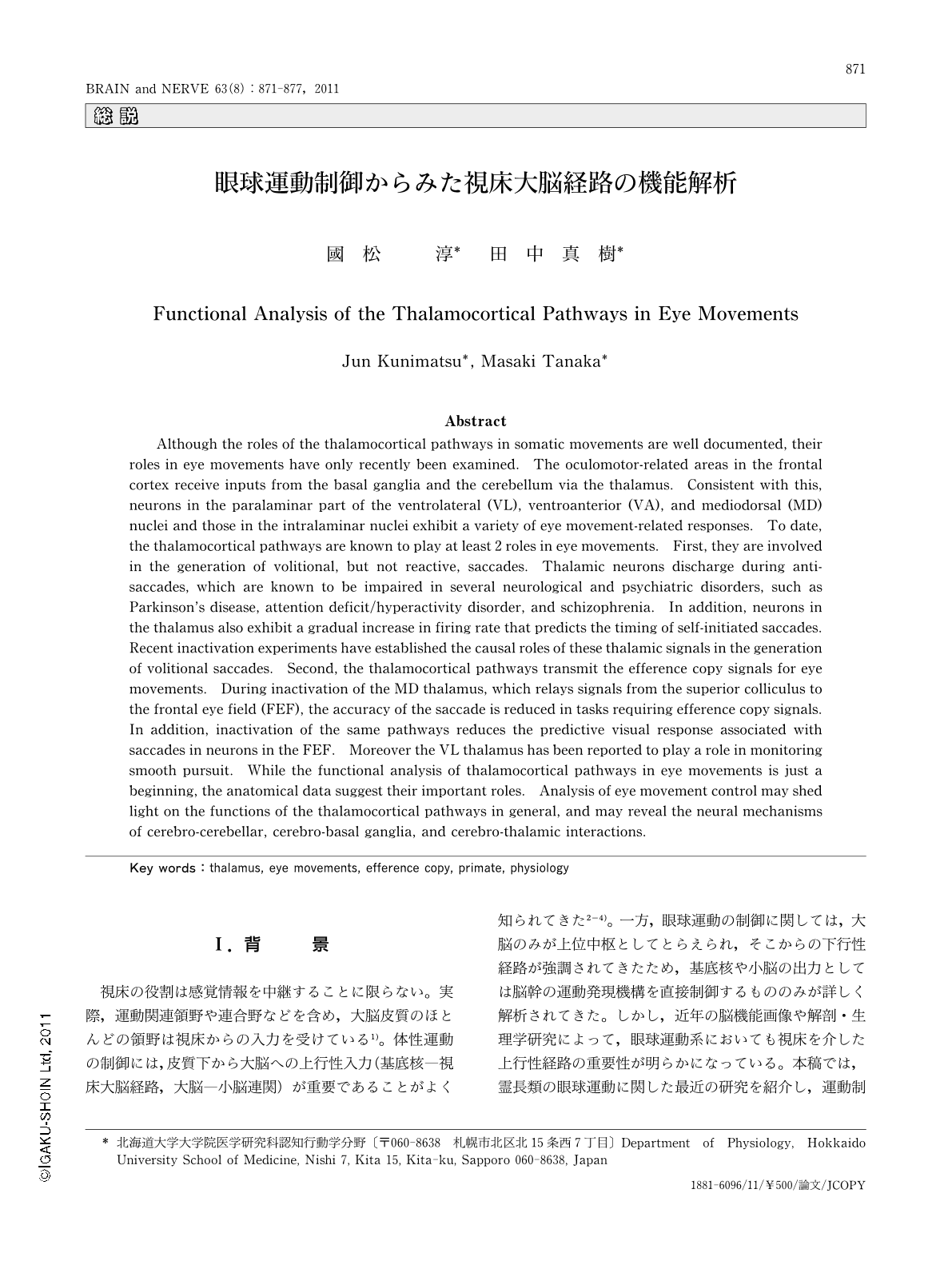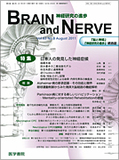Japanese
English
- 有料閲覧
- Abstract 文献概要
- 1ページ目 Look Inside
- 参考文献 Reference
Ⅰ.背景
視床の役割は感覚情報を中継することに限らない。実際,運動関連領野や連合野などを含め,大脳皮質のほとんどの領野は視床からの入力を受けている1)。体性運動の制御には,皮質下から大脳への上行性入力(基底核―視床大脳経路,大脳―小脳連関)が重要であることがよく知られてきた2-4)。一方,眼球運動の制御に関しては,大脳のみが上位中枢としてとらえられ,そこからの下行性経路が強調されてきたため,基底核や小脳の出力としては脳幹の運動発現機構を直接制御するもののみが詳しく解析されてきた。しかし,近年の脳機能画像や解剖・生理学研究によって,眼球運動系においても視床を介した上行性経路の重要性が明らかになっている。本稿では,霊長類の眼球運動に関した最近の研究を紹介し,運動制御における視床大脳経路の役割について考察する。
視床にはいくつもの核があり,大きく特殊核と非特殊核に分けられる。特殊核は特定の皮質下領域からの投射を受けるとともに,明確に定位される大脳領野と相互に連絡しあっている。一方,非特殊核は基底核,小脳,脳幹などさまざまな領域からの入力を受け,大脳皮質に広汎に投射する。眼球運動に関しては,前頭眼野および補足眼野に逆行性のトレーサーを注入した多くの研究報告があり,Fig.1はLynchら(2006)5)によってまとめられた投射経路の概要である。
Abstract
Although the roles of the thalamocortical pathways in somatic movements are well documented,their roles in eye movements have only recently been examined. The oculomotor-related areas in the frontal cortex receive inputs from the basal ganglia and the cerebellum via the thalamus. Consistent with this,neurons in the paralaminar part of the ventrolateral (VL),ventroanterior (VA),and mediodorsal (MD) nuclei and those in the intralaminar nuclei exhibit a variety of eye movement-related responses. To date,the thalamocortical pathways are known to play at least 2 roles in eye movements. First,they are involved in the generation of volitional,but not reactive,saccades. Thalamic neurons discharge during anti-saccades,which are known to be impaired in several neurological and psychiatric disorders,such as Parkinson's disease,attention deficit/hyperactivity disorder,and schizophrenia. In addition,neurons in the thalamus also exhibit a gradual increase in firing rate that predicts the timing of self-initiated saccades. Recent inactivation experiments have established the causal roles of these thalamic signals in the generation of volitional saccades. Second,the thalamocortical pathways transmit the efference copy signals for eye movements. During inactivation of the MD thalamus,which relays signals from the superior colliculus to the frontal eye field (FEF),the accuracy of the saccade is reduced in tasks requiring efference copy signals. In addition,inactivation of the same pathways reduces the predictive visual response associated with saccades in neurons in the FEF. Moreover the VL thalamus has been reported to play a role in monitoring smooth pursuit. While the functional analysis of thalamocortical pathways in eye movements is just a beginning,the anatomical data suggest their important roles. Analysis of eye movement control may shed light on the functions of the thalamocortical pathways in general,and may reveal the neural mechanisms of cerebro-cerebellar,cerebro-basal ganglia,and cerebro-thalamic interactions.

Copyright © 2011, Igaku-Shoin Ltd. All rights reserved.


